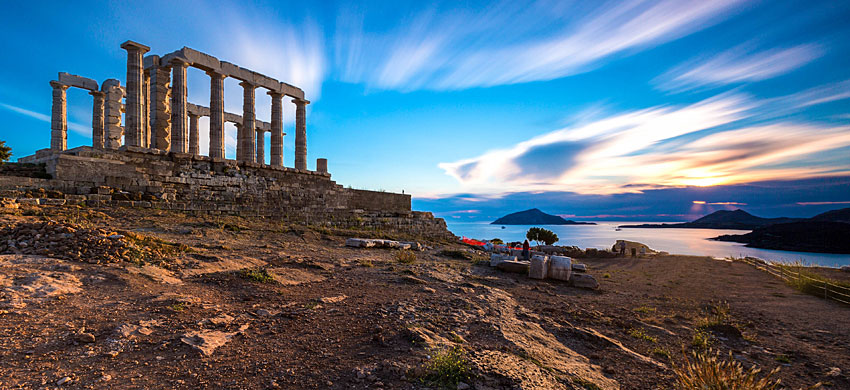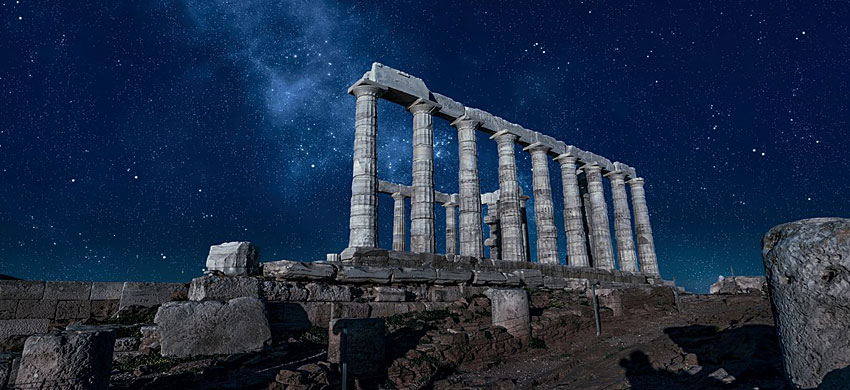
Cape Sounion is a promontory that rises not far from Athens on the southern tip of Attica and is a truly fascinating place steeped in myths and legends. According to myth, it was from this strip of land that King Aegeus, ruler of Athens, threw himself out of despair into the sea that would later take his name, the Aegean Sea. The promontory was also mentioned in Homer’s Odyssey as a sanctuary and important burial place.
Historically, it is known that this site was frequented as early as the end of the 8th century B.C. and over time it became increasingly important, so much so that the remains of a Greek temple dedicated to Poseidon and traces of a second temple dedicated to Athena can still be found here, in a picturesque position overlooking the sea.

Going to Cape Sounion means visiting an ancient archaeological site but also admiring wonderful views. The great temple was dedicated to Poseidon, who in Greek mythology was the god of all the seas; externally this boasted a façade with 6 columns supporting the entablature and the tympanum, while continuing there was a Doric peristyle with no less than 42 marble columns, most probably from the island of Paros.
Unfortunately, only 18 of these 42 columns have come down to us, while the entablature bore votive friezes, also made of Paros marble, which are now in the National Archaeological Museum in Athens.
During excavations in a pit not far from the temple, the imposing statue of Kouros was also found buried with other statuettes. This sculpture made of precious marble was most probably located inside the temple and immediately impressed with its large size as it is more than three metres high. This work is now also on display in the National Archaeological Museum.
Given the location of Cape Sounion overlooking the Aegean Sea, the best time of day to visit it is definitely in the afternoon as you can then admire a beautiful sunset from there.
The most popular way for tourists to visit Cape Sounion is to join an organised tour that includes transport from Athens. There are several tour agencies that offer day trips with dedicated buses and tour guides who will explain the history and highlights of the area. We have selected some recommended tours below.

Greek mythology relates that Aegeus, one of the ancient kings of Athens, sent his son Theseus to the island of Crete to kill the Minotaur that inhabited the labyrinths of the Palace of Knossos. According to the agreement made with his father, if Theseus returned victorious from the feat, his ships were to hoist white flags. Theseus, however, forgot his promise and returned with black flags hoisted, so his father sighted the ship from afar and despaired, thinking his son was dead, and decided to throw himself off the promontory of Cape Sunius. It is said that after this story, the sea that bathes this legendary place took the name Aegean Sea.
The stories linked to Cape Sounion, however, did not end there, since ‘Sounion Hiron’ (i.e. the Sanctuary of Sounion) is also mentioned by Homer in his Odyssey. According to the poet, Phrontes Onetorides, the helmsman of Menelaus’ ship who died on the return voyage from the city of Troy, was also buried here.

Also known as Cape Sounion, or during Venetian rule as Cape Colonne, this promontory is a site with a very ancient history. Frequented since the 8th century B.C., the first certain news about the site comes from Herodotus, who tells of a procession during which the Athenian chiefs travelled to the promontory by sea in a sacred boat.
The presence of a religious site here, however, dates back to earlier times, since already during the Persian wars it was the destination of processions and ceremonies dedicated to the god Poseidon. The present temple was later rebuilt in marble and with larger dimensions around 440 BC and then again in 413.
According to archaeological reconstructions, the sacred building was a hexastyle Doric peripteral, i.e. with six columns on the façade, and was dedicated to Poseidon, god of the sea. This temple was, in fact, one of the last symbols that ships leaving for war saw, but it was also one of the first to be spotted by returning vessels.
In the late 18th and early 19th century, this place became very popular, especially among wealthy travellers and writers, including the Englishman Lord Byron, who left his signature engraved on the base of one of the columns while visiting the site.
The excavations carried out here also brought important archaeological discover ies, as a kouros statue, also known as the Kouros of Sounion, was found and is preserved in the National Archaeological Museum. In addition, the remains of another temple that stood in the area and was dedicated to the goddess Athena were also found here.
At the foot of the promontory that hosts the archaeological site of Cape Sounion, there is a beautiful hotel with a private beach that allows you to reach this place with a short walk. Alternatively, there are many facilities in nearby towns, many of which are right on the seafront and also offer guests a private beach.
Inland, on the other hand, there are facilities such as several simpler and even cheaper but equally cosy B&Bs. Another alternative to consider is to reach Cape Sounion by day from Athens.
To get to Cape Sounion, we recommend that you rent a car and drive along the S91 road from the capital to the coast and overlook the Saronic Gulf, offering a wonderful view of its islands. Also, driving along this route you pass through small typical villages such as Glyfada, Lagonisi, Saronida, Vouliagmeni and Varkiza. Alternatively, there is a shorter and more direct route, the S89, which allows you to reach Cape Sounion from Athens in less than 90 minutes.
Cape Sounion is a beautiful promontory overlooking the Aegean Sea and is approximately 70 km from the centre of Athens and 66 km from Piraeus.